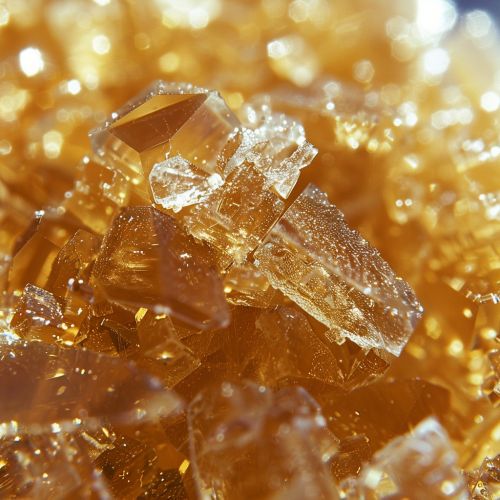Glucose
Introduction

Glucose is a simple sugar with the molecular formula C₆H₁₂O₆. It is a vital carbohydrate in biology, serving as a primary source of energy and a metabolic intermediate. Glucose is one of the main products of photosynthesis and starts cellular respiration in both prokaryotic and eukaryotic cells. It is a monosaccharide, which means it is one of the simplest forms of sugar and cannot be hydrolyzed to give a simpler sugar.
Structure and Properties
Glucose is a hexose, a monosaccharide containing six carbon atoms. It exists in two forms: D-glucose and L-glucose, which are mirror images of each other. The D-form is the one most commonly found in nature and is the form that is metabolized by living organisms.
The structure of glucose can be represented in multiple ways, including Fischer projections and Haworth projections. In aqueous solutions, glucose predominantly exists as a cyclic hemiacetal, forming a six-membered ring structure known as a pyranose. The ring form can exist in two anomeric forms, alpha (α) and beta (β), which differ in the orientation of the hydroxyl group attached to the first carbon atom.
Biological Role
Energy Source
Glucose is a primary energy source for cells. It is metabolized through glycolysis, where one molecule of glucose is broken down into two molecules of pyruvate, generating a net gain of two molecules of ATP (adenosine triphosphate). Pyruvate can then enter the citric acid cycle (Krebs cycle) and oxidative phosphorylation to produce additional ATP.
Storage
In animals, excess glucose is stored as glycogen in the liver and muscles. Glycogen can be rapidly mobilized to meet sudden needs for glucose. In plants, glucose is stored as starch, which can be broken down into glucose units when needed.
Precursor to Other Biomolecules
Glucose is a precursor for the synthesis of several important biomolecules. It is involved in the synthesis of nucleotides, amino acids, and fatty acids. The pentose phosphate pathway, which branches from glycolysis, generates NADPH and ribose-5-phosphate, necessary for nucleotide synthesis.
Metabolism
Glycolysis
Glycolysis is the metabolic pathway that converts glucose into pyruvate, generating ATP and NADH. This process occurs in the cytoplasm and does not require oxygen, making it an anaerobic process. Glycolysis consists of ten enzymatic steps, starting with the phosphorylation of glucose by hexokinase and ending with the production of pyruvate.
Citric Acid Cycle
The citric acid cycle, also known as the Krebs cycle, takes place in the mitochondria. Pyruvate produced from glycolysis is converted into acetyl-CoA, which enters the citric acid cycle. This cycle generates high-energy electron carriers NADH and FADH₂, which are used in oxidative phosphorylation to produce ATP.
Oxidative Phosphorylation
Oxidative phosphorylation is the final stage of cellular respiration, occurring in the inner mitochondrial membrane. NADH and FADH₂ produced from glycolysis and the citric acid cycle donate electrons to the electron transport chain, driving the production of ATP through chemiosmosis.
Regulation of Blood Glucose Levels
Hormonal Regulation
Blood glucose levels are tightly regulated by hormones, primarily insulin and glucagon. Insulin, produced by the beta cells of the pancreas, lowers blood glucose levels by promoting the uptake of glucose into cells and stimulating glycogen synthesis. Glucagon, produced by the alpha cells of the pancreas, raises blood glucose levels by stimulating glycogen breakdown and gluconeogenesis.
Homeostasis
Maintaining glucose homeostasis is crucial for normal body function. Hyperglycemia (high blood glucose) and hypoglycemia (low blood glucose) can both have serious health consequences. Diabetes mellitus is a common disorder of glucose homeostasis, characterized by chronic hyperglycemia.
Clinical Significance
Diabetes Mellitus
Diabetes mellitus is a group of metabolic disorders characterized by chronic hyperglycemia. It is classified into two main types: Type 1 diabetes, caused by autoimmune destruction of pancreatic beta cells, and Type 2 diabetes, characterized by insulin resistance and relative insulin deficiency. Management of diabetes involves monitoring blood glucose levels, dietary modifications, and medications to control blood glucose.
Hypoglycemia
Hypoglycemia is a condition characterized by abnormally low blood glucose levels. It can result from excessive insulin administration, prolonged fasting, or certain medical conditions. Symptoms of hypoglycemia include shakiness, sweating, confusion, and in severe cases, loss of consciousness. Treatment involves the immediate intake of glucose or carbohydrate-rich foods.
Industrial and Commercial Uses
Glucose is widely used in the food industry as a sweetener and a source of fermentable sugar. It is used in the production of confectionery, beverages, and baked goods. In the pharmaceutical industry, glucose is used in intravenous fluids to provide energy and maintain blood glucose levels in patients who cannot eat.
